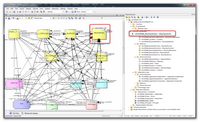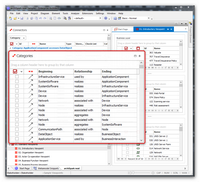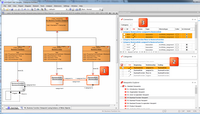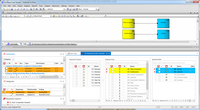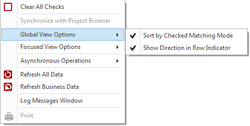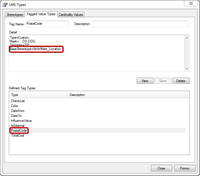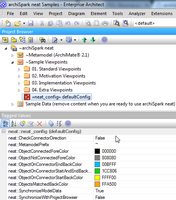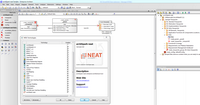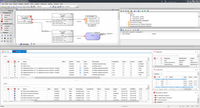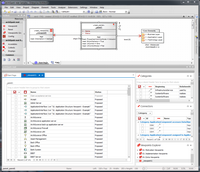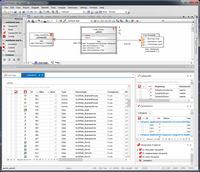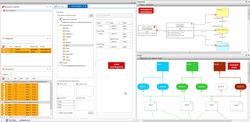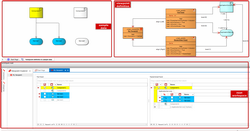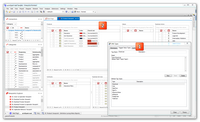Frequently Asked Questions
-
What is a meta-model?
Meta-model is a set of meta-objects and meta-connectors used to describe all the allowed objects and the connections allowed between these objects in your business data. In neat a meta-model is a set of “instructions” telling neat, how to behave in the complicated world of entities and links between these entities in such a way as to make modeling with the use of ArchiMate 2.1® simple.
The meta-model is an integral part of the Sparx Enterprise Architect project, in which you want to use neat. Meta-objects and meta-connectors of the meta-model always begin with a prefix and usually it is "~". The number of objects and connectors in the meta-model seen from the perspective of Sparx Enterprise Architect is terrifying, but fear not. This data is already there and working with it, is not really difficult. From the point of view of neat the meta-model is seen through the prism of Categories, meaning a set of records in which the starting meta-object, the meta-connector and the ending meta-object, allow for a simpler way to describe the meta-model. -
What is a meta-object and what is an object?
The meta-object is an entity which tells neat, which business objects to service. For example, an object with a name of "~Business Actor” in the Sparx Enterprise Architect project data, represents a meta-object and its characteristics are Stereotype (<<ArchiMate_BusinessActor>>) with a basic type of (Class). All objects which have the same characteristics as Stereotype (<<ArchiMate_BusinessActor>>) with a basic type of (Class), i.e. "Client", "Back Office" (see sample neat data) are treated as objects which are compliant with the "~BusinessActor" meta-object.
-
What is a meta-connector and what is a connector?
Meta-connector is an entity, which tells neat, which connectors (relationships) to service. For example a connector with a name of Architect "~UsedBy" in the Sparx Enterprise Architect project data, represents a meta-connector and its characteristics are Stereotype (<<ArchiMate_UsedBy>>) with a basic type of (Dependency). All connectors which have the same characteristics as Stereotype (<<ArchiMate_UsedBy>>) with a basic type of (Dependency) are treated as connectors which are compliant with the meta-connector "~UsedBy".
-
What is a category?
Category is a logical connection of three entities: the starting meta-object, the meta-connector and the ending meta-object. To enable you to follow your business data in neat, Category lets you group connectors and their endings by using categories. Category is a way of moving through the tangle of connectors. Category is a simpler way of looking at the meta-model.
Category is a section of the meta-model containing only the meta-connector and its endings…. But category is something more than Relationship because it clearly and precisely defines which entities can be at the endpoints of a relationship (connector). As you can see on the screenshots, you can have many <<ArchiMate_Assignment>>, connectors, but there are only two connectors which are described by the category: BusinesActor assigned to BusinessRole, which is based on the meta-connector ~assignment. Categories are visible in the dock window neat Categories. -
What is the difference between a meta-connector and a category?
Category is a term which is broader in meaning than meta-connector. In order to describe a category we need a meta-connector as well as a starting meta-object and an ending meta-object of said meta-connector.
-
What is metadata?
Metadata as neat understands it, is the meta-model and the data of viewpoint definitions. You will use the metadata for the creation of viewpoint definitions. Metadata differs from business data, because it does not appear as business data in viewpoints. Metadata can be freely expanded.
-
What is a model?
Model is the data which appears in viewpoints and which is compliant with the meta-model prevailing on the viewpoint.
-
What is non-neat data?
Non-neat data is data which is neither metadata nor data of the neat model.
-
What are meta-object instances and what can I use them for?
Meta-object instance is an instance of any given meta-object which has a prefix of the meta-model. Meta-model instances are useful in creating viewpoints with a limited number of meta-connectors (as well categories in the neat window). Their usefulness is based on the fact that while removing meta-connectors between instances you are not modifying the base meta-model.
-
What is a viewpoint?
According to the ArchiMate®2.1 specification: A viewpoint in ArchiMate is a selection of a relevant subset of the ArchiMate concepts (and their relationships) and the representation of that part of an architecture that is expressed in different diagrams.. In neat subsets of concepts which are of interest to us are visible in the form of data grids. In neat a viewpoint consists of: one or more panels with data objects, a set of categories as well as connectors which are compliant with viewpoint categories.
-
What is a panel?
Panel is a visible fragment of a viewpoint used to manage the objects of the model. Each panel has its own definition specifying: which meta-objects should be displayed, in what mode to function, and in what properties this object data is visible in the panel.
-
The term popup menu often appears. What does it mean?
A popup menu (context menu) is, depending on the situation, either a neat application menu or a Sparx Enterprise Architect menu, available upon clicking the secondary mouse button.
-
How to run neat?
Launch Sparx Enterprise Architect. Then in Sparx Enterprise Architect click Show neat in menu EXTENSIONS | archiSpark neat.
-
Can neat be started on a project without neat metadata?
If Sparx Enterprise Architect does not find the metadata in the project data, then it will start the Load Metadata window and will ask you if you want to load metadata into the project.
-
What exactly is loaded when loading metadata in the Load Metadata window?
The Load Metadata window imports the following into your project:
- meta-objects and meta-connectors of the ArchiMate®2.1 specification;
- viewpoint definitions proposed by us, build based on the viewpoints suggested in the ArchiMate®2.1 specification - Standard Viewpoints, Motivation Viewpoints, Implementation Viewpoints, as well as some exemplary definitions in the framework of the Extra Viewpoints group;
- exemplary model data, from examples of the ArchiMate® 2.1. specification along with diagrams.
-
Can I change metadata after loading it into a Sparx Enterprise Architect project?changed
You can change all loaded data, meta-model, viewpoint definitions and most of all you should remove exemplary model data and unused meta-model items. Model data is loaded so that you understand how neat operates. When you are ready to use neat with your own data, remove exemplary data, diagrams and unused meta-objects and meta-connectors from a Sparx Enterprise Architect project. All viewpoint definitions implemented in metadata are only our proposals as far as viewpoint implementations. You can freely change them, so as they will fit your needs in the best possible manner. Excessive viewpoint definitions can be removed from a Sparx Enterprise Architect project.
-
Does neat burden Sparx Enterprise Architect, while starting Sparx Enterprise Architect?
While starting Sparx Enterprise Architect only MDG neat with add-in is loaded Neat does not load any libraries or data.
-
Why does the first loading of neat take so long?
During the first loading a lot of time is required for the loading of additional UI libraries.
-
When working with neat, is it possible to open a Sparx Enterprise Architect project different from the one with which neat was opened?
Yes it is. neat will receive information from Sparx Enterprise Architect that projects were changed and will reload its data. If the newly opened project will not contain neat metadata then neat will propose loading it.
-
Which RDBMSs does neat support?
archiSpark neat supports: MySQL; SQL Server; Oracle 9i; 10g or 11g; PostgreSQL; MSDE Server, MS Access 97, 2000, 2003, 2007.
-
Which RDBMS is not supported by neat?
archiSpark neat does not support Firebird; Informix; Ingres; SQLLite; Sybase Adaptive Server Anywhere (Sybase ASA); Sybase Adaptive Server Enterprise (Sybase ASE) RDBMSs.
If you need one of these RDBMSs to work with neat, then let us know. -
Are there any tips and hints that should be followed?new
Yes, maybe these tips help you:
- Try to see all the feature movies.
- Try to study the tutorials.
- Use FAQ...Yep, you use it now:)
- Do not leverage on production the whole ArchiMate® 2.1 meta-model items (especially more than two thousand meta-connectors is completely useless).
- Build your own meta-model either from skretch or by disposing of unused meta-objects and meta-connectors after loading metadata.
- Create own viewpoints or change the existing ones.
- Obey the prerequisites (see: Hardware and Software Requirements)
- Try not to use NEAT without performing a prior inspection of data entry, with previously initiated projects based on Enterprise Architect, containing extensive amount of data (Enterprise Architect is not strict in verifying any data in respect to any metamodel)
-
Upon starting neat a Log Messages window always appears. Why?
This window informs you about errors and alerts connected with the metadata and its quality. Metadata is serviced on the Sparx Enterprise Architect platform and is very sensitive to accidental changes. If for example, somebody changes a viewpoint definition, in a way which is not compliant with the specifications, e.g. removes the <<neat_assmbles>> connector, then such a viewpoint becomes wrongly defined and information about this fact can be found in the log. Each record of the Log Messageswindow, if possible, is automatically synchronized with the proper position in the Project Browser of Sparx Enterprise Architect. We believe that the message content in the window is comprehendible and clear enough for you not to have problems with understanding it and its proper interpretation.
-
What can I do using the neat popup menu?changed
Popup menu allows you to:
- Clear All Checks - Clear all net-checks in each open viewpoint.
- Synchronize with Project Browser - Synchronizes the focused object with Project Browser of Sparx Enterprise Architect. This option is only available when: neat::SynchronizeWithProjectBrowser=false.
- Sort by Checked Matching Mode in Global View Options submenu - When turned on it causes sorting of panel records according to given object connections (relationships).
- Show Direction In Row Indicator in Global View Options submenu - When turned on it causes a graphic representation of ending and starting logical points for a given connector (relationship) in viewpoint data grids to appear.
- Row Auto Height in Focused View Options submenu - When turned on it causes adjusting every row height to the cell content on the panel. It works in the scope of the selected panel.
- Create | Delete | Update in Asynchronous Operations submenu - When turned on it causes the selected type of operation (Create | Delete | Update) acts in the background without blocking UI if possible.
- Refresh All Data - Refreshing all project data (meta data and model).
- Refresh Business Data - Refreshing only neat model data.
- Log Messages Windows - Displaying or hiding of the Log Messages window.
- Print - Printout of the panel active in the viewpoint.
-
What does displaying properties in viewpoint panels depend on?
Displaying of properties (panel columns) depends on the panel operating mode neat::PropertiesVisibilityMode and the meta-objects attached to the panel. If you attach the meta-object "~BusinessActor" to the panel, because this meta-object services the property tag MDG actorkind, then this property will be displayed by default (in the modes Blended and Exclusion). If you want to display a tag property which is not defined as tag MDG for the meta-object or tag TVT, then even if you input this property in panel settings it will not be displayed. Remember that the property column will be displayed even if the data which it fits with is missing from the repository (applies to tags MDG and TVT).
-
I cannot edit properties in the viewpoint? Why not?
Editing properties is possible if the property column is compliant with the meta-object with which the property is connected. I.e. you will not be able to set up the value of the tag actorkind on the object which is compliant with the meta-object "~BusinessFunction" due to the fact that actorkind is dedicated to "~BusinessActor".
Furthermore you will not be able to edit the PostalCode properties on objects other than the meta-object "~Location" ((constructed as a pair [<<ArchiMate_Location>>; Class]). -
Why do I see all the connector tags in the Connectors window?
In version 0.9 we have decided not to allow property display steering in Connectors and rather stick to displaying predefined basic properties Id, Name, Type, Stereotype, as well as all tags on connectors. We believe that the amount of information on connectors which will be stored (in tags) will be significantly lower than on model objects. That is why we have decided not to allow connector display steering, which will facilitate using neat. We await your opinion on this subject.
-
Is it possible to work with object instances of the ArchiMate® 2.1 model?
Due to the fact that Sparx Enterprise Architect itself does not ensure proper support in the framework of MDG ArchiMate® object instances (they lose among others things, shape scripts) we have decided, in order to provide simple and clear solutions, that object instances of the ArchiMate® model will not be supported. However we are prepared for it, and if you believe that such a functionality is necessary we can turn it on. We await your opinion on this subject.
-
Can I change metadata after loading it into a Sparx Enterprise Architect project?
You can change all loaded data, meta-model, viewpoint definitions and most of all you should remove exemplary model data. Model data is loaded so that you understand how neat operates. When you are ready to use neat with your own data, remove exemplary data and diagrams from a Sparx Enterprise Architect project. All viewpoint definitions implemented in metadata are only our proposals as far as viewpoint implementations. You can freely change them, so as they will fit your needs in the best possible manner. Excessive viewpoint definitions can be removed from a Sparx Enterprise Architect project.
-
How can I export data from neat into another document?
You can export panel content data by using the Print function. To do this set the focus on any panel data record and choose the Print option from the popup menu. Then, after the document appears choose the option File | Export Document. Available export formats are: PDF, HTML, RTF, XLS, XLSX, CSV, TXT.
-
How to change the way neat operates?
The way neat operates can be changed by changing the object <<neat_config>>.
-
How to change the object <<neat_config>>?
You must find the object with a stereotype of <<neat_config>> in the metadata.
After finding said object you can change specific tags, which correspond to the way neat operates.
-
What can I set up in the configuration object <<neat_config>>?
Global configuration (on the level of the project) includes:
- neat::CheckConnectorDirection - Strong verification of the Direction field in connector properties in relation to meta-connector settings.
- neat::MetamodelPrefix - Changing of the meta-model data prefix, by default set to ~.
- neat::ObjectConnectedForeColor - Font color of the object record for which there exists, at least one connector in the viewpoint.
- neat::ObjectNotConnectedForeColor - Font color of the object record for which there are no connectors in a viewpoint.
- neat::ObjectOnConnectorEndBackColor - Background color of the object record, which is a logical endpoint for a given relationship category.
- neat::ObjectOnConnectorStartAndEndBackColor - Background color of the object record, which is both a logical starting point and an ending point for a given relationship category.
- neat::ObjectOnConnectorStartBackColor - Background color of the object record, which is a logical starting point for a given relationship category.
- neat::ObjectsMatchedBackColor - Background color of the category record and connector record, for which the connected objects have been found.
- neat::SynchronizeModelData - Turning on or turning off model data synchronization from Sparx Enterprise Architect to neat.
- neat::SynchronizeWithProjectBrowser - Turning on or turning off data synchronization in neat grids with Project Browser of Sparx Enterprise Architect.
-
How many <<neat_config>> objects can exist in a Sparx Enterprise Architect project?
Only one. In the case of a missing object or a greater number of objects neat will notify you of an error in the Log Messages window.
-
How can I return to the standard settings of the dock windows in neat?
When your dock windows setting does not suit your expectations then you can return to the standard settings manually moving dock-windows or finding the file archiSpark.neat.userdata.xml on the hard drive and simply removing it. This file is saved in the AppData\Local\archiSpark.neat neat folder in the user profile and it is a hidden file. After removing the file and restarting neat once again, neat dock windows will return to the standard settings.
-
How do I change the meta-model prefix?
If you want to change the prefix, you must set up a new [neat::MetamodelPrefix] value in the <<neat_config>> configuration object. This change tells neat – treat objects and connectors with a new prefix, as meta-model data. After changing the prefix the data will be loaded in the Load Metadata window , however it will still be loaded with the standard prefix ~. You must change it manually which will be very onerous or use the database tool which will improve the exchange operation. We do not encourage you to change the meta-model prefix unless you find it absolutely necessary.
-
How to add you own, simple viewpoint?
To add your own viewpoint to a project with a metamodel, it is enough to create a diagram based on MDG archiSpark neat. The diagram must consist of at least these things:
- one viewpoint object <<neat_viewpoint>>,
- one panel object <<neat_panel>>.
-
Furthermore you must:
- connect the viewpoint with the panel connector <<neat_assembles>>,
- add either the meta-object or the whole packet with meta-objects to the panel with the <<neat_displays>> connector,
-
How to define panel placement in a viewpoint?
To define panel placement in a viewpoint, there are three steering tags:
- To define viewpoint orientation neat::Orientation = (Vertical | Horizontal) in the object <<neat_viewpoint>>.
- To define panel placement neat::VerticalAlignment = (Top | Middle | Bottom), neat::HorizontalAlignment = (Left | Center | Right) on the connector <<neat_assembles>>.
-
How can I define which properties are to be displayed in the panel?
There are three modes of displaying panel properties, which you define through the steering tag neat::PropertiesVisibilityMode on <<neat_panel>>:
- Blended - when you want to display all the tags and only the indicated basic properties of objects,
- Exclusion - when you want to display all tags and all the basic properties of objects,
- Inclusion - when you want to display tags and basic properties of objects indicated by you.
For example let’s take the basic property Name set to Scope=Public. What will neat do in each of the modes?- Blended - Name will be displayed next to all the tags available on the viewpoint,
- Exclusion - all the basic properties are displayed, therefore Name will be displayed as well. In this mode declaring properties which are not to be displayed, changes nothing,
- Inclusion - Name and only Namewill be displayed.
And now let’s set Scope=Private for the same basic property Name. What will neat do in each of the modes?- Blended - Name is not displayed anyway, therefore telling neat not to display Name will not change anything,
- Exclusion - all basic properties are displayed, therefore telling neat not to display Name will cause it to be removed from the panel,
- Inclusion - in this mode Name is not displayed anyway, therefore telling neat not to display Name will not change anything.
-
What basic object properties does neat support?
For objects these are: Name, Alias, Status, Note, Type, Stereotype, Complexity, Phase, Version, Author, Created, Modified.
-
What basic connector properties does neat support?
For connectors these are: Name, Type, Stereotype.
-
What kind of UI controls can be used in the panel?
At the present the panel can function either with Grid control, or Pivot control:
In order to work with Grid or Pivot control in the panel, you must set the panel steering tag neat::UIControl respectively to the value of Grid or Pivot.
-
In what modes can the panel function?
The Grid panel can function in two modes:
- Flat - all the data in the control is displayed in a flat manner,
- MasterDetail - the data is displayed in a hierarchy defined by the neat::DisplayOrder steering tag number value in the neat_display connector set. Each level of detail associated with the master object record shows object records connected with this object (master) for all the Categories of the viewpoint.
-
How do I configure a panel to work in the MasterDetail mode?
In order to work with hierarchical data in the MasterDetail mode, you must set the panel steering tag neat::UIControlMode to the value MasterDetail and connect at least two meta-objects to this panel, for each of them setting up the steering tag neat::DisplayOrder to 0 and 1, 2, 3 respectively on the neat_displays connector. In addition if you want to observe and manage objects (e.g. to connect them with new connectors), on detail levels (e.g. 1), not connected with objects on Master levels (e.g. 0), then set the panel steering tag neat::ShowOrphans to value of true(by default such value is set up for each newly created panel from MDG).
-
How can I narrow down the list of categories for my viewpoint?
In such a situation you must base your viewpoint construction on meta-object instances.
-
Can the meta-connector or meta-object instances have different names than the meta-connector or meta-object which correspond to them?
Meta-object or meta-connector instances can be named in any way you want. However, it is very important to remember the prefix which serves as a means of differentiating metamodel from model data.
-
Does the viewpoint definition based on meta-object instances have to be compliant with the meta-model?
It does not have to be. You can, for example, introduce your own meta-connector which will be followed and managed only on this one single viewpoint.
-
How do I add more than one meta-object to the panel?
In the panel operating mode neat::UIControlMode=Flat you can add any number of meta-objects and panels with meta-objects. Simply add them using the connector <<neat_displays>>. In the mode neat::UIControlMode=MasterDetail you can add only one meta-object or only one packet on each level – 0, 1, 2… (steering tag neat::DisplayOrder). Warning: In order to use meta-connectors between meta-objects added directly to the panel and those found in the packet (they are not shown in the viewpoint definition) you should not use meta-object instances (because they have no relationships with the meta-model).
-
Can I have more than one meta-object with the same parameters [stereotype;type] in the metadata?
No. You can have only one meta-object described by the pair [stereotype;type]or 0 or more instances of this meta-object.
-
How can I narrow down the list of categories for my viewpoint?
In such a situation you should base your viewpoint construction on meta-object instances. Warning: If you use the meta-model you will permanently remove the meta-connectors (relationships), thus degrading the meta-model which will not be compliant with the specification of ArchiMate® 2.1.
-
How do I change a meta-object to an instance of a meta-object?
In Sparx Enterprise Architect transfer the meta-object from the meta-model onto the diagram and using the Sparx Enterprise Architect popup menu choose the option Advanved | Convert to Instance or Advanved | Convert to Invocation. Give the new object a prefix compliant with the prefix in global settings (neat::MetamodelPrefix). From now on the object is an instance of the meta-object.
-
I have created a viewpoint based on instances of the meta-objects and have removed excessive meta-connectors, yet I still have more Categories than I wanted to have. Why?
When you decide to construct a viewpoint based on an instance of the meta-object, remember that in a viewpoint having more than one meta-object, as soon as you convert the first one, excessive relationships between the metamodel and the meta-object instance will be created. You must remove them in the meta-object instances window.
-
Can I add a package with meta-object instances to the panel?
No. You can not.
-
How do I add my own Tagged Value Type?
This is really simple. Add a compound type, using the Tagged Value Types option in Settings | UML Types in compliance with Help Sparx Enterprise Architect [1].
Start neat and use advanced neat editors which support your type [2]. -
Which basic Tagged Value Types does neat support?
archiSpark neat supports Tagged Value Types: Boolean, CheckList, Color, Custom, Date, DateTime, Directory, Enum, File, Float, Decimal, Double, Integer, Memo, Spin, String, URL providing advanced editors which support each of your types based on the above-mentioned Tagged Value Types.
-
Which basic Tagged Value Types are not supported by neat?
archiSpark neat does not support (and neither does it display in grids) Tagged Value Types:
- AddinBroadcast - because this is a strictly technical TVT, which is specific to Sparx Enterprise Architect,
- Classifier - because this TVT is marked by Sparx itself as Deprecated,
- RefGUID - because neat is based on the idea of a meta-model and supporting this TVT would disrupt this idea,
- RefGUIDList - same as RefGUID.
-
How does neat deal with wrongly defined compound Tagged Value Types?
As far as possible neat tries to detect wrongly defined individual tag types. However, it is not always possible. When it is possible and your Tagged Value cannot be serviced properly, you will receive information about it in the log. When it is possible neat will allow the type to be serviced. However we should ask ourselves the question why Sparx Enterprise Architect does not do it, even though it is its integral functionality and it forces add-in suppliers to answer just such questions asked by final users.
-
What modes of synchronization does neat support?
neat operates in the following modes::
- No synchronization - local work without synchronization of changes from Sparx Enterprise Architect to neat,
- Auditing – remote work on projects with many users working on a Sparx Enterprise Architect project at the same time,
- Events – local work with the possibility to synchronize data from Sparx Enterprise Architect to neat
-
Are changes made to the project by other users visible in neat, while in the Auditing mode of synchronization?
Yes.
-
Are changes made to the project by other users visible in neat, while in the Events mode of synchronization?
No they are not. This is how API Sparx Enterprise Architect works.
-
Which synchronization mode is best for me?
If you are telecommuting with many other users at the same time, choose the Auditing mode. If you are working on a local project of Sparx Enterprise Architect and you are going to make changes in data both in neat as well as through UI Sparx Enterprise Architect, then choose the Events mode. If you will work only in neat and will not need synchronization of changes in Sparx Enterprise Architect than choose the No synchronization mode. Warning: Data changed in neat always goes to a Sparx Enterprise Architect project, regardless of the mode of synchronization you choose.
-
Does work in Auditing and Events synchronization modes influence ergonomics of using neat?
Yes. Working with Auditing synchronization mode turned on influences work comfort because API Sparx Enterprise Architect does not provide you with API methods informing you of remote changes, and verification of data is completely up to neat. Working in the Events mode is less cumbersome, however API Sparx Enterprise Architect does not inform you of all the changes, that have happened to your business data.
-
Where do I set up the Auditing or Events mode?
The choice between Auditing and Events depends on project settings in Sparx Enterprise Architect. To set up the Auditing mode, turn on the Enable Auditing option in Project | Auditing | Audit Settings of Sparx Enterprise Architect. The details of operation of this mode can be found in Help of Sparx Enterprise Architect.
-
How do I set up the synchronization which is right for me?
In the configuration object <<neat_config>> set up [neat::SynchronizeModelData] either with the value of true if you want synchronization to work, or false if you want to work in the No Synchronization mode. If you entered true neat will operate in the synchronization mode which is suitable for the Sparx Enterprise Architect project settings.
-
Can I synchronize grid records in a panel with Sparx Enterprise Architect Project Browser?
Yes you can. To do it change the value to true in the steering tag [neat::SynchronizeWithProjectBrowser] of the <<neat_config>> object. However, remember that synchronization uses API Sparx Enterprise Architect and bringing up the API takes time. If you do not have to synchronize objects with Project Browser in real-time, then do not turn on synchronization of neat with Project Browser (set [neat::SynchronizeWithProjectBrowser] to false), because if the need arises you can synchronize objects of the model in the Project Browser using the Synchronize with Project Browser option in the neat popup menu.
-
Can I synchronize focus of record connectors (Connectors) with Sparx Enterprise Architect Project Browser?
Unfortunately no. Sparx Enterprise Architect does not provide you with API to synchronize connectors.
-
Does neat support security mechanisms?
Yes, if in a Sparx Enterprise Architect project security policy is turned on.
-
Does neat support locks?
neat respects and supports the lock mechanism, but from the level of neat you can neither put a lock on objects or packages nor remove it from them.
-
Does neat support permissions?
Yes, neat supports permissions for users and groups in a range which is necessary for neat to function in compliance with the security policy of Sparx Enterprise Architect.
-
What permissions must a user have in order to use neat?
In order to perform the operations Create, Update or Delete, it is necessary to have the Update Elements permission. To read and look through data this permission is not needed. In order to hide connector links in the framework of the Add connector operation, it is necessary to have the Update Diagrams permission. In order to import neat metadata into a project it is necessary to have the Import XMI permission.
-
How do the Create, Update and Delete operations on objects and connectors work?
Besides verifying rights to edit data in real-time, neat also verifies security policy on the level of objects on which you are currently working. neat respects locks, user rights and group rights on the levels of objects and logical (business) starting points of connectors. In order to perform an operation such as Create, Update or Delete on a connector you must have the rights to perform such operations on a logical starting point of this connector.
-
What will happen if while working with neat I will log off and relog as a different user?
Sparx Enterprise Architect does not inform the addin type application about change of user. If while working, you logged off and relogged as a different user, perform the Refresh All Data operation in the popup menu. The information about the user which is currently logged on, as far as neat in concerned, will be found on Start Page.
-
The Create Operation (in the Add Connector window) for meta-connectors: ~influences (ArchiMate_Influences stereotype), ~triggers (ArchiMate_Triggering stereotype), ~flows (ArchiMate_Flow stereotype)
Connectors ArchiMate_Influences, ArchiMate_Triggering, ArchiMate_Flow are based on the ControlFlow basic type, which functions on the dynamics description objects. However ArchiMate® 2.1 objects between which you can apply these connectors are from outside of the scope of the dynamic behaviors description. Something that works in a Sparx Enterprise Architect diagram may not work in a Sparx Enterprise Architect automatization interface. API Sparx Enterprise Architect is currently validating the creation of the new connector before the stereotype is applied, so the ArchiMate-specific validation rules are not being performed. To get around it, disable the Strict UML Syntax option in Tools | Options | Diagram, in order not to get an exception, which will be generated by Sparx Enterprise Architect API. In a situation, where neat finds operations on these connectors it will inform you about potential problems in the functioning of Sparx Enterprise Architect.
-
neat addin as Sparx Enterprise Architect docking window
If you take neat outside of the tab in which it generally docks, using the options which Sparx Enterprise Architect offers you in the range of the window docking functionality, then if you once again pull neat into the tab, this tab will lose its name. These are the limitations of Sparx Enterprise Architect for each addin. Due to the fact that addins are recognized on stack addins by their names, as soon as you lose a name, you can experience unpleasant repercussions connected with it. I.e. if you reload a project on such a nameless neat, you will be able to start neat once again, despite the fact that one has already been started.
-
Operations Create and Delete for tags in the Events mode
We have noticed and we do not know what it depends on, that if a tag is created in or removed from Sparx Enterprise Architect, then API Sparx Enterprise Architect does not always inform its addins about this fact. We believe that, this is connected with the quality of data in the Sparx Enterprise Architect project itself. If you encounter similar behavior of neat on your project, be aware of the fact that we are conscious of this situation, but due to lack of information from Sparx Enterprise Architect itself, neat is not able to react properly and update business data in neat. The best thing to do then, is to use the Refresh Business Data option.
-
Lack of validation of compound type definitions based on Tagged Value Types
Unfortunately Sparx Enterprise Architect does not verify the compound type definition based on Tagged Value Type. Despite a well-defined and limited set of supported Tagged Value Types, Sparx Enterprise Architect does not parse data put in by the user, which is a shame. It is up to you, the user, to do it correctly, and to locate an error in your definition, if your definition does not work according to your expectations. neat tries to cope with it by introducing a simple verification of definitions, but it does not have a definition compiler built-in. If neat decides that a definition is incorrect, than you will find such information in the Log Messages window. If neat decides that the definition allows for the performing of Create and Update operations, based on the definition of a complex Tagged Value, then neat will try to service it. Before you start using a new compound type definition based on Tagged Value Type in neat, check, how it works in Sparx Enterprise Architect itself.
-
Copying and import operations in the Project Browser
API Sparx Enterprise Architect does not inform you about performing an import data operation or finishing of data copying (Elements or Packages). If neat is running and you have performed an import or a copying operation then use the Refresh All Data option in the neat popup menu to synchronize the data.
-
Quick Linker and problems with filling in the Stereotype field
Working with QuickLinker on Sparx Enterprise Architect diagrams, a situation can occur in which, while linking objects with an ArchiMate® connector, the stereotype field of the created connector will not be filled in properly. We have noticed such behavior of Sparx Enterprise Architect e.g. for the connector ArchiMate_Association.
-
Security Policy of operations on connectors
Sparx Enterprise Architect does not function according to its own Help as far as the Create operations on connectors. Actions for the Update and Delete operations are once again not coherent with the Create operation described in Help of Sparx Enterprise Architect. In this matter neat is more restrictive and assumes that you have the permission to perform operations such as Create, Update and Delete on a connector if you have the permission to perform such an operation on the logical (business) starting object of said connector.

